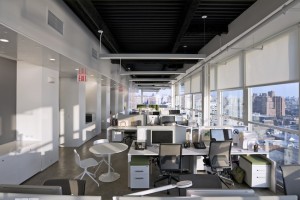A good, successful brand is a living, breathing aspect of your organization. Encompassing what your brand represents at its core, and directly impacting those with whom it interacts.
Your office space can (and should) become an extension of your brand. It should embody the characteristics to which your brand relates. In short, your employees should see the brand all around them – from where the office is located, to what they see when they walk in the building, to how their lives are shaped by the brand they work for.
Seems like a simple concept, right? Not so fast. A CoreNet/Steelcase research article that had some pretty amazing statistics with regard to branding, including this graphic:

Interestingly, just 50 percent of respondents felt that their office design was brand consistent – way below more on the surface branding efforts like the appearance of logos, advertising and products. These branding elements are important, yes, but do they accomplish much in the way of turning your employees into brand advocates by bringing your branding to life? I doubt it. This is one of the reasons why branding and your office design/features should work hand-in-hand.
Here are a few tips on how to bring your brand to life around (and outside) the office:
Talk to your employees about what the brand means to them.
Find out what characteristics they can most relate to, and work to include elements in the design that capture the essence of how your employees see your brand. Again, they are the most important audience in this area of your branding. Additionally, they may show you a side of your brand that you never thought would be at the top of their priority list, but you find out it should be, helping drive your strategy.
Say your employees keep coming back to how your brand promotes collaboration and interaction – two characteristics that are difficult to communicate through a logo, but can easily be translated into a working space that is open, free from traditional office walls and barriers, that allows for coworkers to easily communicate throughout the day.
Your branding can extend outside your walls. 
When brand engagement firm Sullivan relocated their New York City offices to the High Line building in Manhattan, they looked to their new neighborhood as an inspiration for the design of their new digs. They saw how the area’s personality matched with what they felt their brand represented, and knew that the energy all around them would translate with the energy their employees felt when going to work.
They also incorporated design elements take straight from their surroundings, including vintage furniture and naming their breakout tables and pods by a different cut of meat (such as “brisket,” “sirloin” and “ribeye”), to invoke the history Meatpacking District they call home.
Don’t just walk the walk – talk the talk.
Gaming company Zynga, known for such games as Words with Friends and FarmVille, recently moved into a new space and wanted to design it in a way the encompassed what they felt the brand represented. So, they focused on bringing their culture to life. CEO Mark Pincus put the strategy in motion early on, when he knew that an active, healthy culture was an important area for Zynga to represent, so their new headquarters needed to include a state-of-the-art gym for employees to use. This is a good example of taking something that is often discussed but rarely acted upon – how your brand can improve the lives of your employees – and taking action.
Image Sources:
https://workdesign.com/2012/06/how-one-branding-firm-branded-its-own-space/
https://360.steelcase.com/wp-content/uploads/2011/02/Whitepaper-Brand-and-Culture-V1.4.pdf
https://workdesign.com/2015/02/pluralsight-encourages-working-playing-winning-together/
Addison Whitney is a global branding firm with a passion for building strong brands.
To learn more about Addison Whitney, visit our website at AddisonWhitney.com, or contact us here.
